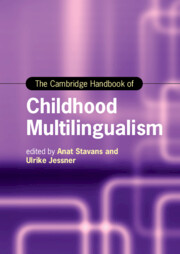Book contents
- The Cambridge Handbook of Childhood Multilingualism
- Cambridge Handbooks in Language and Linguistics
- The Cambridge Handbook of Childhood Multilingualism
- Copyright page
- Contents
- Figures
- Tables
- About the Editors
- Contributors
- Acknowledgments
- Multilingualism Is Not Bilingualism +1: An Introduction
- Part One Becoming and Being a Multilingual Child
- Part Two Cognition and Faculties in Multilinguals
- Part Three Family Language Policy
- Part Four Language(s) and Literacy of Multilingual Children through Schooling
- 15 Being Plurilingual in the Language Classroom
- 16 Literacy Development in the Multilingual Child: From Speaking to Writing
- 17 Attitudes, Motivations, and Enjoyment of Reading in Multiple Languages
- 18 Growing Up with Multilingual Literacies and Implications for Spelling
- 19 Assessing Multilinguals
- 20 Plurilingualism and Young Children’s Perspectival Cognition
- Part Five Socialization in Childhood Multilingualism
- Part Six Multilingual Children’s Landscape
- Subject Index
- Country Index
- Language Index
- References
17 - Attitudes, Motivations, and Enjoyment of Reading in Multiple Languages
from Part Four - Language(s) and Literacy of Multilingual Children through Schooling
Published online by Cambridge University Press: 18 August 2022
- The Cambridge Handbook of Childhood Multilingualism
- Cambridge Handbooks in Language and Linguistics
- The Cambridge Handbook of Childhood Multilingualism
- Copyright page
- Contents
- Figures
- Tables
- About the Editors
- Contributors
- Acknowledgments
- Multilingualism Is Not Bilingualism +1: An Introduction
- Part One Becoming and Being a Multilingual Child
- Part Two Cognition and Faculties in Multilinguals
- Part Three Family Language Policy
- Part Four Language(s) and Literacy of Multilingual Children through Schooling
- 15 Being Plurilingual in the Language Classroom
- 16 Literacy Development in the Multilingual Child: From Speaking to Writing
- 17 Attitudes, Motivations, and Enjoyment of Reading in Multiple Languages
- 18 Growing Up with Multilingual Literacies and Implications for Spelling
- 19 Assessing Multilinguals
- 20 Plurilingualism and Young Children’s Perspectival Cognition
- Part Five Socialization in Childhood Multilingualism
- Part Six Multilingual Children’s Landscape
- Subject Index
- Country Index
- Language Index
- References
Summary
Psychosocial factors strongly influence language learning and reading achievement for children. Evidence indicates a strong positive relationship between attitudes toward reading in the first (L1) and second or third languages (L2/L3) and subsequent reading achievement among multilinguals. Many studies of children learning to read demonstrate direct positive relationships between intrinsic motivation and reading achievement. Other studies have found that extrinsic motivation is the motivational facet that most predicts achievement. Researchers have begun to consider how the relationship between reading attitudes in one language might affect reading motivation and outcomes for another language. In this chapter we examine relevant theoretical frameworks of motivation and psychosocial factors that influence language learning and reading. Next, we present state-of-the-field findings regarding psychosocial factors related to reading achievement among multilingual children. We discuss how to reconcile contradictory findings and consider which features of language and context may be salient for predicting relationships. Finally, we make recommendations for future research and consider pedagogical implications.
- Type
- Chapter
- Information
- The Cambridge Handbook of Childhood Multilingualism , pp. 393 - 414Publisher: Cambridge University PressPrint publication year: 2022



